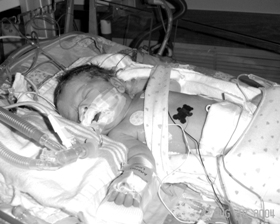Kestrel McDonald’s story
By Mary Ann PriceParents of child with EA/TEF reaching out to other parents of children born with same defect
Kestrel McDonald’s parents describe their daughter as a typical 6 year old. A first grade student at the Kennedy School, she enjoys sledding, singing, drawing and dancing.
What is different about Kestrel is that she was born with esophageal atresia/tracheo-esophageal fistula (EA/TEF), a birth defect that affects about one in 4,000 babies, according to the EA/TEF Child and Family Support Connection website.
In babies born with EA, the esophagus — which connects the mouth to the stomach — is shortened and closed off (dead ended) at some point along its length. EA almost always occurs in conjunction with tracheoesophageal fistula (TEF), a condition in which the esophagus is improperly attached to the trachea, the “windpipe” that carries air into the lungs.
Heather Fairfield, Kestrel’s mother, said her pregnancy with Kestrel was a fairly normal one — until about the fifth month, when she began to put on weight to the point that shoppers stopped her in the supermarket to ask if she was expecting twins. Following several ultrasounds and an MRI to check on Fairfield’s baby, the doctors suspected that there was a blockage in the baby’s esophagus, which caused Fairfield to develop polyhydramnios, excess amniotic fluid in the amniotic sac. A baby in the womb will normally swallow and breathe in the amniotic fluid. When a mother is carrying a baby with EA/TEF, however, the fistula can restrict the normal flow of amniotic fluid, causing it to build up. In Fairfield’s case, a measurement of her abdomen when she was 33.5 weeks pregnant was comparable to a woman who was 43 weeks pregnant.
“The human body was not built to withstand such things,” Fairfield wrote in an e-mail to friends at that time. “I am already getting very short of breath very quickly when I move around …”
On August 17, 2004, Fairfield, who was 38 weeks pregnant, delivered six-pound, six-ounce Kestrel by emergency Caesarean section at Newton-Wellesley Hospital. She was diagnosed with EA/TEF a few hours after her birth, when nurses had trouble feeding her. “The lower part of her esophagus was misconnected to her windpipe,” Fairfield said. “Some air would go into her stomach, but there was nowhere for food to go. She was drowning in her own stomach acid.”
Kestrel was moved to Children’s Hospital, and by the time she was two months old, she had undergone three surgeries. “They reconnected everything,” her mother said.
Faifield recalls how her now vivacious 6-year-old daughter did not meet certain developmental milestones as a baby — like rolling over — because she spent so many weeks lying in a hospital crib.
Six years later, Kestrel’s activities are not restricted. “The biggest thing that holds her back now are the respiratory issues,” Fairfield said. “She has reactive airway disease, and if she tries to run around during cold weather, she’ll usually go into a bronchospasm and need her inhalers. There have been two or three times so far this year when she has not been able to go outside for recess with her class, because of her breathing issues.”
Kestrel’s diet — although always affected by the EA/TEF — has improved over the years. “In the past, after a few bites, she’d sound like she was breathing through a wet dishrag,” Fairfield said, adding that Kestrel still has trouble sometimes with chunky foods because of the loss of motility — the way food moves from the esophagus to the stomach. Although she does much better than other children with EA, Kestrel sometimes has to take a drink of water to help get the food down. “Or she does the ‘jumpy dance,’ where she jumps up and down to get the food down,” Fairfield said, adding that because Kestrel has a very tough time managing food and mucous secretions at the same time, it’s especially difficult when she is sick. To add to the problem, Kestrel has chronic respiratory illnesses and is susceptible to viral infections.
Fairfield said the worst thing about her daughter’s condition now is the “dreaded” TEF cough, a symptom shared by all children with TEF. “It’s caused by a weakness in the trachea, and does not indicate that the child is sick in any way,” Fairfield said. “But you should see the looks you get in public or on the playground when your child starts up with this horrible barking cough. It sounds like she’s got some kind of horrible respiratory infection when she may not even be sick at all. I actually had a woman confront me in a Brueggers one time and yell at me — at the top of her lungs — for bringing my ‘sick child’ into a restaurant to spread germs all over her food. Unfortunately, a lot of other moms and dads of EA/TEF kids have been confronted in a similar manner.”
Kestrel’s father, Michael McDonald, knows that his daughter will have questions about EA/TEF as she grows older. “I see her looking out the door at other kids [playing outside] and wondering why?”
Which is the same question her parents had when their beautiful baby was born.
“When she was born, there was no one for us to talk to,” Fairfield said. “I don’t want to have other parents go through what we went through.”
January is National Birth Defects Prevention Month and Fairfield and McDonald want to reach out to parents of other children with EA/TEF.
Two online resources for families are www.bridgingthegapofea-tef.com and a Face book page called “Bridging the Gap of Ea/tef: US.” In addition, Bridgewater resident Lori McGahan has created Brandon’s Run in honor of her son, who was born with EA/TEF. The 50-mile motorcycle run benefits the Esophageal Atresia Treatment Program (EAT Program) at Children’s Hospital. The fifth annual Brandon’s Run will be held August 27, 2011, beginning at the Middleboro Elks. More information is available at www.brandonmsrun.com.
Short URL: https://www.thecantoncitizen.com/?p=409












